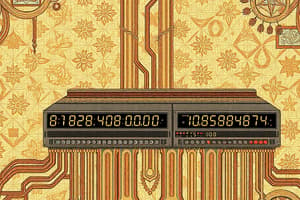Podcast
Questions and Answers
What happens to Q0 when the positive-going edge of CLK2 occurs?
What happens to Q0 when the positive-going edge of CLK2 occurs?
- Q0 remains unchanged
- Q0 is RESET
- Q0 goes HIGH
- Q0 goes LOW (correct)
What is the state of Q0 and Q1 after the leading edge of CLK3?
What is the state of Q0 and Q1 after the leading edge of CLK3?
- Q0 = 1, Q1 = 1 (correct)
- Q0 = 0, Q1 = 0
- Q0 = 1, Q1 = 0
- Q0 = 0, Q1 = 1
How many different states does the 2-bit counter exhibit?
How many different states does the 2-bit counter exhibit?
- 8
- 4 (correct)
- 2
- 3
What happens to the counter when it receives the fourth clock pulse?
What happens to the counter when it receives the fourth clock pulse?
What is the significance of the term 'recycle' in counter operation?
What is the significance of the term 'recycle' in counter operation?
What type of counter is shown in Figure 1?
What type of counter is shown in Figure 1?
What is the purpose of the flip-flop FF1 in the counter circuit?
What is the purpose of the flip-flop FF1 in the counter circuit?
How many flip-flops are required to implement a 3-bit binary counter?
How many flip-flops are required to implement a 3-bit binary counter?
What is the main difference between a 2-bit counter and a 3-bit counter?
What is the main difference between a 2-bit counter and a 3-bit counter?
What happens when an input clock pulse is applied to an asynchronous counter?
What happens when an input clock pulse is applied to an asynchronous counter?
What is the term used to describe the clocking effect in asynchronous counters?
What is the term used to describe the clocking effect in asynchronous counters?
What is the reason for the propagation delay in an asynchronous counter?
What is the reason for the propagation delay in an asynchronous counter?
How many clock pulses are shown in the timing diagram of Figure 3?
How many clock pulses are shown in the timing diagram of Figure 3?
What is the maximum count of a 3-bit asynchronous binary counter?
What is the maximum count of a 3-bit asynchronous binary counter?
How does the counter change state on the leading edge of CLK4?
How does the counter change state on the leading edge of CLK4?
What is the time delay between the positive-going transition of Q0 and the positive-going transition of Q1?
What is the time delay between the positive-going transition of Q0 and the positive-going transition of Q1?
What is the significance of omitting small delay and timing differences in a timing diagram?
What is the significance of omitting small delay and timing differences in a timing diagram?
What is the role of FF0 in the 3-bit synchronous binary counter?
What is the role of FF0 in the 3-bit synchronous binary counter?
What happens to Q1 every time Q0 is a 1 in the 3-bit synchronous binary counter?
What happens to Q1 every time Q0 is a 1 in the 3-bit synchronous binary counter?
What is the purpose of connecting Q0 to the J1 and K1 inputs of FF1?
What is the purpose of connecting Q0 to the J1 and K1 inputs of FF1?
What is the effect of the CLK8 pulse on the 3-bit synchronous binary counter?
What is the effect of the CLK8 pulse on the 3-bit synchronous binary counter?
What is the relationship between J0 and K0 inputs of FF0 in the 3-bit synchronous binary counter?
What is the relationship between J0 and K0 inputs of FF0 in the 3-bit synchronous binary counter?
Why are propagation delays important in high-speed digital circuits?
Why are propagation delays important in high-speed digital circuits?
What is the primary role of the 3-bit synchronous binary counter?
What is the primary role of the 3-bit synchronous binary counter?
What is the main characteristic of an asynchronous counter?
What is the main characteristic of an asynchronous counter?
In a 2-bit asynchronous binary counter, which flip-flop is triggered by the clock pulse?
In a 2-bit asynchronous binary counter, which flip-flop is triggered by the clock pulse?
What is the trigger for FF1 in a 2-bit asynchronous binary counter?
What is the trigger for FF1 in a 2-bit asynchronous binary counter?
What happens to the Q0 output of FF0 when the clock pulse goes HIGH?
What happens to the Q0 output of FF0 when the clock pulse goes HIGH?
What is the effect of the Q0 output going LOW on FF1?
What is the effect of the Q0 output going LOW on FF1?
What is the initial state of the flip-flops in the asynchronous counter?
What is the initial state of the flip-flops in the asynchronous counter?
What is the reason for the asynchronous operation of the counter?
What is the reason for the asynchronous operation of the counter?
What is the logic equation for the J0 and K0 inputs of FF0 in the BCD decade counter?
What is the logic equation for the J0 and K0 inputs of FF0 in the BCD decade counter?
What happens to the Q1 output of FF1 after the leading edge of CLK1?
What happens to the Q1 output of FF1 after the leading edge of CLK1?
What is the condition for FF1 (Q1) to change on the next clock pulse in the BCD decade counter?
What is the condition for FF1 (Q1) to change on the next clock pulse in the BCD decade counter?
What is the logic equation for the J2 and K2 inputs of FF2 in the BCD decade counter?
What is the logic equation for the J2 and K2 inputs of FF2 in the BCD decade counter?
What is the condition for FF3 (Q3) to change to the opposite state on the next clock pulse in the BCD decade counter?
What is the condition for FF3 (Q3) to change to the opposite state on the next clock pulse in the BCD decade counter?
What is the main difference between the BCD decade counter and the modulus-16 binary counter?
What is the main difference between the BCD decade counter and the modulus-16 binary counter?
What is the purpose of the Q0Q3 AND gate in the BCD decade counter?
What is the purpose of the Q0Q3 AND gate in the BCD decade counter?
What is an up/down counter?
What is an up/down counter?
Flashcards are hidden until you start studying
Study Notes
Asynchronous Counters
- An asynchronous counter is a type of counter where flip-flops (FF) do not change states at exactly the same time because they do not have a common clock pulse.
- In an asynchronous counter, the clock (CLK) is applied to the clock input (C) of only the first flip-flop (FF0), which is always the least significant bit (LSB).
- The second flip-flop (FF1) is triggered by the Q0 output of FF0, and subsequent flip-flops are triggered by the previous flip-flop's output.
- Because of the inherent propagation delay time through a flip-flop, a transition of the input clock pulse (CLK) and a transition of the Q0 output of FF0 can never occur at exactly the same time.
- The counter operation is asynchronous, meaning the flip-flops are never simultaneously triggered.
2-Bit Asynchronous Binary Counter
- A 2-bit asynchronous binary counter consists of two flip-flops (FF0 and FF1) connected for toggle operation (D = Q).
- The counter exhibits four different states, representing a sequence of binary numbers.
- The counter counts the number of clock pulses up to three, and on the fourth pulse, it recycles to its original state (Q0 = 0, Q1 = 0).
Timing Diagram
- A timing diagram illustrates the changes in the state of the flip-flop outputs in response to clock pulses.
- The diagram shows the waveforms of the Q0 and Q1 outputs relative to the clock pulses.
3-Bit Asynchronous Binary Counter
- A 3-bit asynchronous binary counter consists of three flip-flops (FF0, FF1, and FF2) connected for toggle operation (D = Q).
- The counter exhibits eight different states, representing a sequence of binary numbers.
- The counter counts the number of clock pulses up to seven, and on the eighth pulse, it recycles to its original state (Q0 = 0, Q1 = 0, Q2 = 0).
Propagation Delay
- Asynchronous counters are commonly referred to as ripple counters due to the ripple clocking effect.
- The effect of the input clock pulse is first "felt" by FF0, then propagated to subsequent flip-flops, causing a delay in the counter's operation.
- The propagation delay through each flip-flop is a critical factor in the asynchronous counter operation.
3-Bit Synchronous Binary Counter
- A 3-bit synchronous binary counter consists of three flip-flops (FF0, FF1, and FF2) connected for toggle operation (D = Q).
- The counter exhibits eight different states, representing a sequence of binary numbers.
- The counter counts the number of clock pulses up to seven, and on the eighth pulse, it recycles to its original state (Q0 = 0, Q1 = 0, Q2 = 0).
BCD Decade Counter
- A BCD (Binary Coded Decimal) decade counter is a type of counter that counts from 0 to 9 in decimal.
- The counter consists of four flip-flops (FF0, FF1, FF2, and FF3) connected for toggle operation (D = Q).
- The counter's operation is controlled by logic equations that implement the BCD counting sequence.
Up/Down Synchronous Counters
- An up/down counter is a type of counter that is capable of progressing in either direction through a certain sequence.
- Up/down counters are used in applications where counting in both directions is required.
Studying That Suits You
Use AI to generate personalized quizzes and flashcards to suit your learning preferences.




